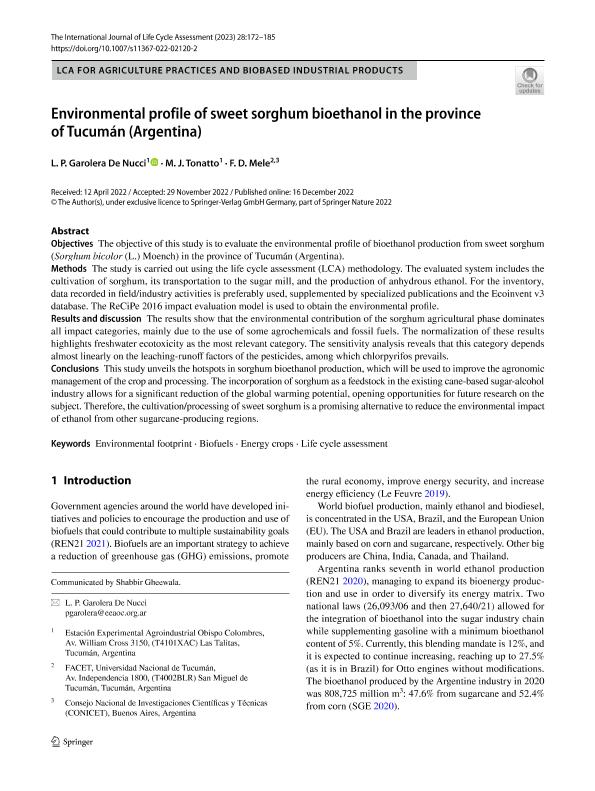Mostrar el registro sencillo del ítem
dc.contributor.author
Garolera De Nucci, Lorena Patricia
dc.contributor.author
Tonatto, Mario Javier

dc.contributor.author
Mele, Fernando Daniel

dc.date.available
2023-10-17T17:15:26Z
dc.date.issued
2023-02
dc.identifier.citation
Garolera De Nucci, Lorena Patricia; Tonatto, Mario Javier; Mele, Fernando Daniel; Environmental profile of sweet sorghum bioethanol in the province of Tucumán (Argentina); Springer Heidelberg; International Journal Of Life Cycle Assessment; 28; 2; 2-2023; 172-185
dc.identifier.issn
0948-3349
dc.identifier.uri
http://hdl.handle.net/11336/215206
dc.description.abstract
Objectives: The objective of this study is to evaluate the environmental profile of bioethanol production from sweet sorghum (Sorghum bicolor (L.) Moench) in the province of Tucumán (Argentina). Methods: The study is carried out using the life cycle assessment (LCA) methodology. The evaluated system includes the cultivation of sorghum, its transportation to the sugar mill, and the production of anhydrous ethanol. For the inventory, data recorded in field/industry activities is preferably used, supplemented by specialized publications and the Ecoinvent v3 database. The ReCiPe 2016 impact evaluation model is used to obtain the environmental profile. Results and discussion: The results show that the environmental contribution of the sorghum agricultural phase dominates all impact categories, mainly due to the use of some agrochemicals and fossil fuels. The normalization of these results highlights freshwater ecotoxicity as the most relevant category. The sensitivity analysis reveals that this category depends almost linearly on the leaching-runoff factors of the pesticides, among which chlorpyrifos prevails. Conclusions: This study unveils the hotspots in sorghum bioethanol production, which will be used to improve the agronomic management of the crop and processing. The incorporation of sorghum as a feedstock in the existing cane-based sugar-alcohol industry allows for a significant reduction of the global warming potential, opening opportunities for future research on the subject. Therefore, the cultivation/processing of sweet sorghum is a promising alternative to reduce the environmental impact of ethanol from other sugarcane-producing regions.
dc.format
application/pdf
dc.language.iso
eng
dc.publisher
Springer Heidelberg

dc.rights
info:eu-repo/semantics/openAccess
dc.rights.uri
https://creativecommons.org/licenses/by-nc-sa/2.5/ar/
dc.subject
BIOFUELS
dc.subject
ENERGY CROPS
dc.subject
ENVIRONMENTAL FOOTPRINT
dc.subject
LIFE CYCLE ASSESSMENT
dc.subject.classification
Ingeniería de Procesos Químicos

dc.subject.classification
Ingeniería Química

dc.subject.classification
INGENIERÍAS Y TECNOLOGÍAS

dc.title
Environmental profile of sweet sorghum bioethanol in the province of Tucumán (Argentina)
dc.type
info:eu-repo/semantics/article
dc.type
info:ar-repo/semantics/artículo
dc.type
info:eu-repo/semantics/publishedVersion
dc.date.updated
2023-10-12T14:56:57Z
dc.journal.volume
28
dc.journal.number
2
dc.journal.pagination
172-185
dc.journal.pais
Alemania

dc.description.fil
Fil: Garolera De Nucci, Lorena Patricia. Gobierno de Tucumán. Ministerio de Desarrollo Productivo. Estación Experimental Agroindustrial Obispo Colombres; Argentina
dc.description.fil
Fil: Tonatto, Mario Javier. Gobierno de Tucumán. Ministerio de Desarrollo Productivo. Estación Experimental Agroindustrial Obispo Colombres; Argentina
dc.description.fil
Fil: Mele, Fernando Daniel. Universidad Nacional de Tucumán; Argentina. Consejo Nacional de Investigaciones Científicas y Técnicas. Centro Científico Tecnológico Conicet - Tucumán; Argentina
dc.journal.title
International Journal Of Life Cycle Assessment

dc.relation.alternativeid
info:eu-repo/semantics/altIdentifier/url/https://link.springer.com/article/10.1007/s11367-022-02120-2
dc.relation.alternativeid
info:eu-repo/semantics/altIdentifier/doi/http://dx.doi.org/10.1007/s11367-022-02120-2
Archivos asociados
